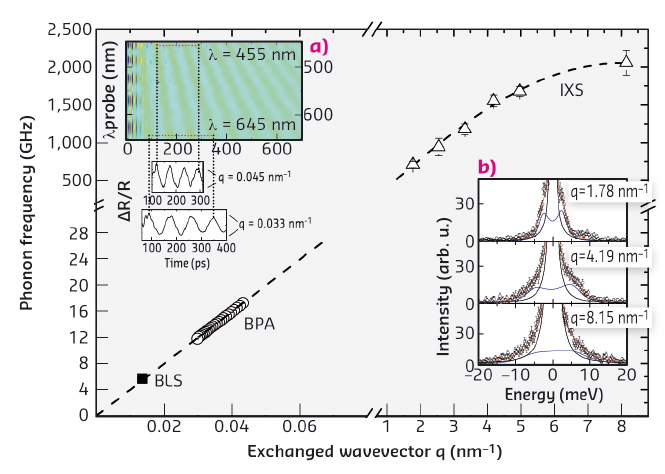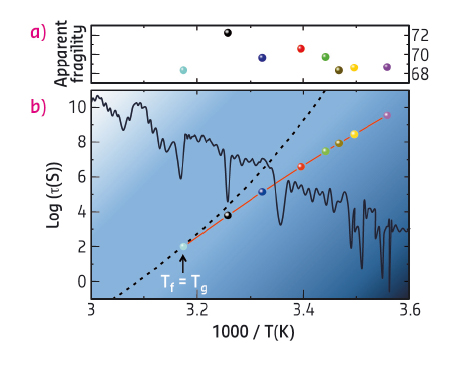- Home
- Users & Science
- Scientific Documentation
- ESRF Highlights
- ESRF Highlights 2015
- Electronic structure, magnetism and dynamics
- How slow does glass flow?
How slow does glass flow?
A fundamental question for glass transition theories is whether an equilibrium glass ceases to flow at some finite temperature. However, direct measurement would require unfeasibly long observation times. An alternative means was provided by relating the ultraviscous flow to the elastic properties of an out-of-equilibrium glass as function of its age.
Glass-forming liquids can be cooled below the melting temperature to a metastable state, avoiding crystallisation. During this process, the molecular diffusion progressively slows down until the system falls out of equilibrium at the glass transition temperature, Tg.
Accordingly, viscosity increases dramatically and, based on its temperature dependence upon approaching Tg, glass-formers are classified into strong or fragile. Strong glass-formers follow an Arrhenius behaviour, i.e. the logarithm of viscosity linearly increases with the inverse of temperature, while fragile glass-formers display a super-Arrhenius behaviour: the faster they slow down, the more fragile they are.
A pivotal aspect for modern glass transition theories is whether this classification is still physically meaningful below Tg, i.e. whether or not viscosity diverges at a finite temperature. Answering this question is hampered by the fundamental unfeasibility of experimental investigations of relaxation processes in the ultraviscous glass state, which would require an impractically-long observation time.
We circumvent these limitations, by extending the correlation [1] between the slow diffusive motion (described by the viscosity) and the vibrational properties of the glass (sound velocity) as function of the age of the glass. The older the glass is, the lower the temperature at which viscosity can be determined.
Being in an out-of-equilibrium state, glasses spontaneously evolve (ageing) towards lower (more stable) potential energy minima (inherent structures) on a timescale dictated by the relaxation time.
Glass stability (or, equivalently, age) can be quantified by determining the fictive temperature Tf from the endothermic jump of specific heat upon fast heating the glass. The lower the Tf, the higher the stability of the glass is.
We used physical vapour deposition (PVD) to rapidly obtain glasses of indomethacin (Tg = 315 K) with Tf ranging from Tg down to 0.88 Tg, corresponding to “ages” reached by standard cooling and waiting for millennia (like if a winemaker could produce a mature wine without having to wait).
Growing samples thicker than a few tens of micrometres by PVD, however, is extremely challenging. By taking advantage of the tight focusing capabilities of beamline ID28, together with the availability of a 9 crystal analysers bench to simultaneously record the inelastic spectra at different fixed values of momentum transfer, we managed to repeat the measurement on PVD films as thin as 50 μm.
 |
|
Fig. 58: Longitudinal acoustic phonon dispersion in ultrastable PVD glass, investigated by BPA (○ and panel a), IXS (∆ and panel b) and Brillouin measurement (□). |
By combining the IXS [2] data with Brillouin light scattering in frequency (BLS) [3] and time domain (BPA), we determined the energy dispersion of the longitudinal vibrational modes in the most stable sample (Figure 58). In the low-frequency region, the linear energy dispersion indicates the existence of propagating vibrational excitations corresponding to a single acoustic-like phonon branch. Remarkably, their propagating nature lingers up to the THz frequency regime, where, because of disorder, the plane-wave description inherited from crystals is no longer valid.
 |
|
Fig. 59: (a) Apparent fragility determined from the sound velocity jump in glasses with different Tf. (b) Arrhenius plot for T < Tg, obtained by integrating data from (a). Sketched in the background (black solid line) is the potential energy minima explored for a glass of fictive temperature T. |
We measured the sound velocity for all the available glasses in order to determine the behaviour of the apparent fragility (Figure 59a), i.e. the generalisation of viscosity temperature steepness index to glasses at Tf << Tg. From the apparent fragility we could finally quantify viscosity along the equilibrium line (Figure 59b). The super-Arrhenius behaviour documented for indomethacin above Tg is reported as a dashed line representing a Vogel-Fulcher-Tamman function. For Tf < Tg a remarkable deviation is observed: the apparent fragility initially increases (though less than expected by the VFT), while decreases below Tf = 295 K indicating a transition from fragile-to-strong system. With this approach, we found an Arrhenius behaviour far below Tg up to exapoise values.
In conclusion, our results suggest that the conventional wisdom picture of a glass ceasing to flow at a finite temperature could be wrong. A reconsideration of old paradigms based on the dynamical divergence may be needed for a definitive understanding of the glass transition to be reached.
Principal publication and authors
Probing equilibrium glass flow up to exapoise viscosities, E.A.A. Pogna (a), C. Rodriguez-Tinoco (b), G. Cerullo (c), C. Ferrante (a), J. Rodriguez-Viejo (b) and T. Scopigno (a), Proc. Natl. Acad. Sci. 112, 2331–2336 (2015); doi: 10.1073/pnas.1423435112.
(a) Dipartimento di Fisica, Universitá di Roma “La Sapienza” (Italy)
(b) Physics Department, Universitat Autònoma de Barcelona (Spain) (c) Dipartimento di Fisica, Politecnico di Milano (Italy)
References
[1] T. Scopigno et al., Science 302, 849-852 (2003).
[2] E.A.A. Pogna et al., Sci. Rep. 3, 2518 (2013).
[3] S. De Panfilis et al., Phys. Chem. Chem. Phys. 16, 14206–14211 (2014).



